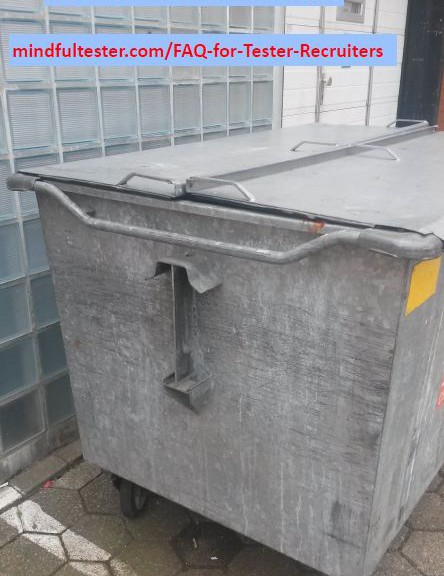An imaginary situation decades ago.
[Phone rings. I pick it up. Interested, who is calling]
I: “Hi”
Caller: “Hi. Joe mentioned you were interested in a blind date.”
I [Pleased to be called]: “Sure.”
Caller: “Are you intelligent?”
I [Ignoring the undertone]: “I am studying at the university.”
Caller: “That’ s great. Can you talk about computers?”
I [Internal sigh]: “I am studying computer science.”
Caller: “Are you attractive?”
I: “Just pretty.”
Caller: “Hum”
I [Annoyed]:”Why can pretty people have no blind dates?”
Caller: “Do you look good in a bikini?”
I [Upset]: “Excuse me. I am a man!”
Caller: “I just thought you had a low voice. Sorry for wasting your time.”
I [Angry]:”What the …”
[Caller ends conversation.]
Standard questions from tester recruiters, which are usually asked at speed date speed
Are you interested in a job?
Yes. I don’t have a job.
[LinkedIn] Can we connect?
If I do not know you, then I will not connect with you. I connect with you, if I trust you.
Would you please call me?
If you provide enough information about your company or customer, I might be willing to call you. It is also handy to provide a phone number.
Would you like to send me your CV?
All relevant information is on LinkedIn. I will send you my CV, if I am interested in the job.
Where do you like to work?
In the Randstad and the area southward to and including Breda.
Do you work and think on an academic level?
Yes. I am an engineer graduated at Eindhoven University of Technology.
How long have you tested?
In 1996 I started with my career as a professional tester. The information can be retrieved from LinkedIn.
Do you have relevant test certificates?
Yes, look at my LinkedIn profile.
Do you know the following test automation tools [tools names]?
I have no experience with test automation, but I have theoretical knowledge. At the moment I am experimenting with Selenium, Eclipse, and Java. I have more than 5 year experience with programming in C and C++.
Do you have experience with scrum?
Yes, one year.
Do you know Cucumber?
No. But I can pick it up.
Do you want to freelance?
No.
I’ve got a job for a test coordinator. Is this interesting?
It depends. I can make test plans and test reports, if necessary. But I prefer to test hands on most of the time.
Do you want to be a senior tester?
Yes. Please.
Do you know other testers, who might be interested in this job?
Yes, I know a lot of good testers. Even excellent ones. In the past I suggested some names. I did not get proper feedback, so I decided to stop mentioning names.
More preferable questions for me from tester recruiters
How can I contact you?
Just send a personalised e-mail.
What is “personalised” according to you?
If I replace my name by the name of a random fellow tester and the mail is still applicable, then it is not personalised.
Do you want to know more about my company or client?
Yes, of course. I am really interested in the way they work, the company culture, and the products / services. I am all ears.
What kind of company are you looking for?
A company, which has agile projects in house.
What is important for you?
I like a company, which is committed to go to the next test level and where I still can develop myself.
How do we stay in touch?
I prefer one contact person.
How often can I ask you something?
If there is an interesting job, you can ask any questions. Please don’t ask the same questions twice. It’s extremely annoying for me, especially if you have my recent CV.
When should I thank you?
- After I sent you an e-mail.
- For this blog post.
Disclaimer
I wrote this blog post on 8 December 2015. Things might have changed in the meantime.




